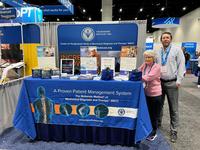News Room
MD Curbs Opioid Use with Mechanical Diagnosis and Therapy
The statistics grow increasingly alarming: tens of thousands of deaths a year due to overdose with more than a half million forecasted for the next decade. On average, 130 Americans die every day with 47,600 opioid overdose deaths in 2017 (67.8 percent of all drug overdose deaths), according to the Centers for Disease Control.
An international study labeled America as the No. 1 consumer in the world and one prominent economist recently produced evidence these drugs are impacting the U.S. workforce. Doctors have received some of the blame for seeding the opioid crisis by prescribing too much too often to address acute pain.
Primary care physicians have worked in recent years to change that. Like his peers, Vikas Agarwal, MD, Cert. MDT, is working to curb the risks of opioid abuse by reducing his patients use of and dependency on it to relieve pain. He's found a solution in physical therapy, particularly the McKenzie Method® of Mechanical Diagnosis and Therapy® (MDT).
He says many times in the medical world, physicians exhaust all their resources with NSAIDS, muscle relaxants, steroids, opioid painkillers, injections and, many times, surgery before turning a patient to physical therapy. In fact, physical therapy is viewed many times as a last modality when most of the medical side is exhausted.
He believes a major part of this comes from lack of appreciation of mechanical pain. In addition, it is hard for physicians to know and understand different kinds and modalities of physical therapy.
"A majority of aches and pains are mechanical in nature," Agarwal says. "That's why mechanical intervention helps in reducing or eliminating the pain rather than suppressing the pain with opioids, which unfortunately the whole medical community has been getting used to.”
Now more than ever physical therapy as part of medical care makes sense, according to Agarwal. He notes that the American College of Physicians (ACP) released evidence-based clinical practice guidelines on low back pain in 2017 that recommend MDs consider different kinds of non-pharmaceutical approaches as their initial treatment modality in acute, sub-acute and chronic low back pain.
"The message from the guidelines is clear: Avoid using any kinds of pills first in approaching low back pain," Agarwal says.
These recommendations are not at all surprising now for Agarwal, who has been an internal medicine physician for more than 20 years and he too used different kinds of pain pills all his career for low back pain prior to discovering MDT.
"Using opioids really doesn't fix the pain, it just suppresses it. And not only that, it actually creates a whole slew of other problems," he says.
He further explains that in general people are aware of opioid addiction and opioid-related overdose (and death). However, in primary care practice, he commonly encounters many opioid-related adverse effects that people may not be aware of.
For example, people are surprised when they learn that their dry mouth or tremors in hands or decrease in sexual libido could be an adverse effect of opioids. And many people are shocked that long-term opioid use can lead to opioid-induced hyperalgesia (OIH) or greater pain sensitivity.
Of course, mental cloudiness, drowsiness, fatigue and gastrointestinal side effects of nausea and constipation significantly affect one’s quality of life and help people put their pain level in perspective. Empowering patients with education about all the individual side effects an opioid can have on them and addressing their mechanical pain with the McKenzie Method has helped him reduce or eliminate opioids for many of his patients.
In fact, a 2016 study analyzing 22,907 patients with pain diagnosis, compared Agarwal with 19 other primary care physicians in his organization and showed his counterparts prescribed six times as many opioid pills per pain patient as Agarwal.
"That's where we need to make this message heard: Mechanical pain is very common, and it can be acute and chronic, and it needs to be addressed," Agarwal says. "I'm a primary care physician and I work with people from different specialties all the time – a cardiologist, nephrologist or a radiologist – and I view MDT as a sub-branch of medicine dealing with mechanical issues.
“Having integrated MDT into patient examinations has revolutionized my primary care practice,” says Agarwal. “Dealing with mechanical issues in the body is essential in understanding the human body just like cardiology, neurology or pulmonary. The importance of using a specific mechanically based approach cannot be overstated and in my first-hand experience, MDT offers a great foundation.”
Agarwal says his introduction to MDT was unplanned, but his interest gradually grew as he read Founder Robin McKenzie's books and experimented with the ideas. Eventually, he discovered The McKenzie Institute® and began work toward certification.
"One of the biggest shocks for me going through the courses was the change in my perception about the MDT therapists," he says. "Traditionally, I and I think a lot of my colleagues viewed physical therapists as technicians. After all, we will write a prescription for physical therapy or sign on their treatment plan as required in many states.
"However, I was blown away by the cognitive thinking and a logical assessment approach that would be required as in any clinical problem solving involving any branch of medicine," he says. "MDT is based on history and examination just like any other branch of medicine. It is scientific, it is logic, it is based on reasoning and it is predictable, reliable and dependable."
Today he helps his patients remedy acute pain in just a few visits, sometimes the same day. Its fast results obviously avoid the need of anti-inflammatory and opioid painkillers in many cases.
With this in mind, Agarwal believes now is the time for MDs to collaborate more with PTs in patient care, particularly with those PTs certified in the McKenzie Method.
"We need to improve awareness of mechanical pain among the physicians and collaborate and empower the MDs by communicating how they can help simple mechanical pain themselves in their practice,” says Agarwal. “Rather than physical therapists and doctors just taking different approaches to patient care.
"I believe that once you understand other people's worlds, you can engage them more effectively to your advantage," Agarwal says. "PTs should emphasize the scientific approach of MDT to physicians because it is really different from other forms of physical therapy."
He adds MDT is an integral modality in understanding the mechanical pain and mechanical issues of the human body, no matter if you are a primary care physician or a neurosurgeon or an orthopedic surgeon or a physical medicine and rehab physician.
"It is the same human body, after all, and the core issues or problems or diagnosis should be the same no matter from what lens you look at it," he says.
Share your news! Send your story to us and we'll post it for everyone to read.




